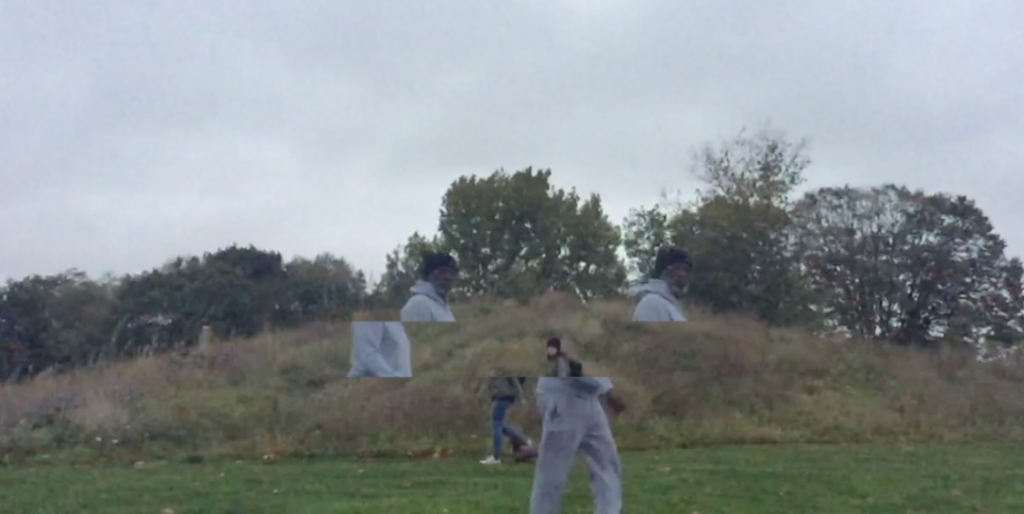Both made under the film studio A24, two films that have made a major impression on me this year are ‘A Ghost Story’, directed by David Lowery, and ‘The Florida Project’, by Sean Baker. Although different in agenda, what I took away from them mutually was the idea of time as a major theme, even though it was dealt with in very different ways.
A Ghost Story – Dir. David Lowery, 2017
The theme of time is more prevalent in A Ghost Story. Centred around the grieving wife of a man who dies suddenly in a car crash whilst he watches her as a ghost, unable to talk to her, it’s a story that explores the enormity of time, somehow managing to fit in hundreds of years worth of experience whilst simultaneously including scenes such as “a five-minute, uninterrupted take in which the wife eats an entire family-size pie slumped on the kitchen floor, then runs to the loo to throw up.”(1)
Even after the ghost’s wife moves out of the house, he stays trapped there, watching the lives of strangers unfold in the house that he should’ve been living in. This silent observation continues until the site of his old home is replaced by a large office building in the middle of a built-up city that has developed around him. He wanders the office block alone for some time until he decides to try and commit suicide (somehow) by jumping off the top of the office block. The scenes that follow are in my opinion some of the most poignant. Instead of leaving forever, he instead is transported back to the very beginnings of his home, and watches the initial stakes of the building being hammered in by a 19th Century European settler and his family. After a few weeks of living on the site and beginning to build the house, the family are killed by Native Americans. The camera lingers on the body of the family’s youngest child, before switching to the ghost watching her silently for a few seconds, unmoving. the camera then switches back to the girl, who now remains only as a rotting corpse, almost completely skeletal. This scene stuck with me as a particularly aching display of the scale of time, and dispelled an ongoing desire of mine to be able to observe a spot forever because of how painfully slow the reality of it is. Although it doesn’t end up being the case, the possibility of infinite time for this ghost is very real, and it’s terrifying.
Trailer:
The Florida Project – Dir. Sean Baker, 2017
If A Ghost Story is a longitudinal look at time, focusing on one place and moving up and down its entire timeline, then perhaps The Florida Project could be described as looking at time laterally, focussing only on the present but narrowing it down to look at a very small group of people in a set geographical location, providing the viewer with a modern-day ‘slice of life’ look into the experiences of a of society that’s often overlooked. Set over the span of a summer holiday, the film follows a 6-year old girl named Moonee living with her young mother in The Magic Castle Inn, a low budget extended-stay motel on W. Irlo Bronson Memorial Highway, Kissimmee, just miles from Disney World itself. It reminds me of J.G. Ballard’s 1974 novel ‘Concrete Island’, set in a derelict ‘island’ underneath the junction of three motorways leading out of London. This spot, so close to the urban sophistication of London, becomes the main character’s own personal hell, just out of public reach yet still very much present. The Florida Project runs in a similar, if less severe, vein.
In one of its reviews for the film, Mark Kermode (The Guardian) wrote, “It all adds up to another superbly sympathetic portrait of marginalised experience from a film-maker whose great triumph is that he never feels like a tourist. This is Moonee’s world, and for a couple of hours at least, we are privileged to live in it.” (2)
I do indeed find it an absolute privilege to be able to observe this world that I myself have been unknowingly so close to when visiting Disney Land as a child and again as a teenager. Although I don’t remember seeing The Magic Castle Inn itself when driving through Kissimmee, there are countless similar locations along the highway. As a 9 year old child, I didn’t notice these ‘in-between’ spots, but on my second trip aged 17 (which was more for my sister, who was 14 at the time) the ‘in-between’ times of driving past cheap gift shops, tiny churches with monumental crucifix’s and run-down i-Hops became a lot more interesting to me than the parks themselves. Although I didn’t get many, I tried to take photos along the highway (shown below) and often wish I could go back to the places in the photos and just observe them without being in a moving vehicle. The Florida Project gave me a chance to do that and I’m extremely grateful for it.





I am however aware that the purpose of The Florida Project isn’t to give viewers a pastel-pretty insight into this problem that they can forget about after watching, or simply ignore in favour of the cinematography. The problems faced by the characters in the film are as real as the motel in which it was filmed, and I don’t want to come across as voyeuristic or uncaring when talking about it. I tried to focus on the elements of the film that run more in parallel with what I’m trying to figure out within my own work, but I am of course mindful that that’s not the point of it, and nor should it be.
Trailer:
(1) https://www.theguardian.com/film/2017/aug/09/a-ghost-story-interview-david-lowery-casey-affleck-rooney-mara-pie
(2) https://www.theguardian.com/film/2017/nov/12/the-florida-project-review-sunshine-state-of-mind
